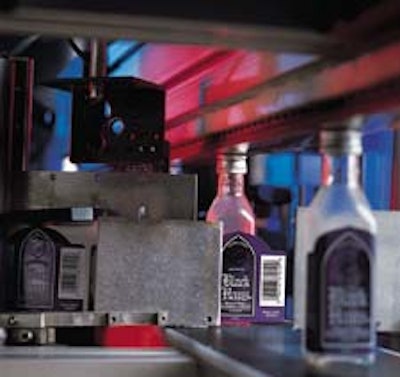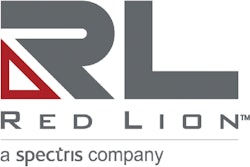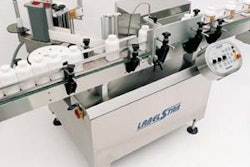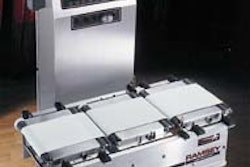Imported from Europe beginning a few years ago, Rumple Minze® and Black Haus® brands of schnapps from Stamford, CT-based United Distillers and Vintners quickly established a loyal following. As sales in the U.S. continued to climb, it soon made sense to produce and package these spirits in North America rather than bottle them in Europe and ship them across the ocean.
In the case of 50-mL miniatures in polyethylene terephthalate, bottling of the new brands for the U.S. market was shifted to UDV’s Toronto facility, where a line dedicated to 50-mL sizes handles a variety of the company’s well-known brands. An essential first step, however, was the installation of a new labeler. The primary driver behind the new labeler was the simple fact that both Rumple Minze and Black Haus are marketed in square, not round, bottles. The 50-mL line’s labeler in the Toronto plant was designed exclusively to handle round bottles.
“The pressure-sensitive labeler we had at the time wouldn’t handle a square bottle,” says Bruce Loveless, maintenance project manager at the Toronto plant. “Especially challenging is the shape of the Black Haus label. The top is pointed, so if that point is even the least bit off center, it shows clearly and the bottle looks bad.”
Speed was another issue. “The old labeler wouldn’t run any faster than 180 bottles per minute,” says Loveless. “We run the new one at 250, and it’s capable of more.” UDV will have a chance to take advantage of those higher speeds when downstream equipment is upgraded later this year.
Three-panel label
Loveless says that when he was shown the three-panel label designed for the square miniatures, he was convinced that only a rotary labeler would be capable of handling such a challenging application at acceptable speeds. “But,” he explains, “we didn’t have much floor space available, and a rotary labeler has a large footprint. So when we learned that an in-line labeler was out there that would do what we needed, we were definitely interested.”
The labeler he is referring to is the Combo system from Labelling Technologies (Mississauga, Ontario, Canada). UDV installed it last September after buying it through Manuel Automated Packaging (Toronto, Ontario, Canada), a local equipment distributor.
“To get the speed, accuracy and reliability we needed, we expected to pay twice what we paid for this labeler,” says Loveless. He’s quick to point out, however, that the machine has important benefits beyond its affordability. For one thing, the servo motors that drive the machine are readily available from inventory at any industrial supply shop, says Loveless. He emphasizes that UDV hasn’t had to replace any servos yet, but he says it’s good to know how accessible they are.
The servos on the labeler were made by Reliance Motion Control (Eden Prairie, MN). Used throughout the labeler, they power the main bottle conveyor, side-chain orienters, overhead conveyor and both labeling heads. Although the labeler is equipped with two labeling heads, only one is used for the Rumple Minze and Black Haus brands.
A Red Lion (York, PA) encoder monitors the revolutions of the labeler’s main drive shaft and relays its precise position to the system’s microprocessor. The microprocessor signals the servos based on the encoder’s input. Thus, the servo motors are all synchronized to the labeler’s main drive shaft.
Easy setup and changeover are also appealing, says Loveless. “It’s a matter of selecting a program from a menu on the touchscreen panel. Then we change the label roll and make some simple mechanical adjustments if the bottle height changes, and we’re done.”
Custom molds
Transferring the bottling to Toronto also meant identifying a new supplier of PET bottles. Wheaton USA (Mays Landing, NJ) got the nod. It uses custom molds to injection/stretch blow-mold the stippled-finish bottles.
Filling and capping equipment stayed the same when the square bottles entered the picture. Bottles leave the capper and are transferred by starwheel onto the infeed conveyor of the labeler. Immediately after, the bottles move under the overhead conveyor, which holds the bottles down on the main conveyor. There’s considerable give where the overhead conveyor meets the bottle finish because behind the belt are springs at regular intervals. This allows the overhead conveyor to apply equal pressure to all bottles being transported even if one is slightly taller or shorter than its peers.
“A bottle can have a slight deformity at the base that causes it to be taller than its neighbors, or a cap can be slightly out of spec,” says Loveless. “But the spring-loaded construction of the overhead conveyor is forgiving enough to accept these deformities without losing control of the bottles or causing a jam.”
Each time an incoming bottle passes a sensor, the labeling head fires, which positions a partially dispensed label squarely in the path of that bottle. The label is picked up as the bottle is conveyed into it. Then a brush on each side brushes the label down onto the two side panels. Side-driven conveyors, spring-loaded like the overhead conveyor, spin the bottles to complete the wipe-down process.
Labels for Rumple Minze and Black Haus brands are both paper. But the machine also applies clear film labels to some of UDV’s round containers. A “capacitive label tracer,” says Labelling Technologies, allows the labeler to detect gaps between clear labels.
Although 11” O.D. label rolls are standard on the Combo labeler, UDV chose an optional package that allows 16” O.D. label rolls. Powered unwinds feed the labeling heads. The larger rolls reduce the amount of downtime caused by label roll changes. Such downtime should be further reduced in the near future as UDV implements a splice-on-the-fly feature provided by Labelling Technologies.
As UDV waits for these final process improvements, says Loveless, the new labeler is everything he’d hoped it would be.
“We run our complete portfolio through this line, from vodka to bourbon,” says Loveless. Accuracy, he adds, is never a problem. “Through quality assurance and packaging audits done continually all day long, we know this labeler is meeting our requirements.”
In a hurry? Request more info via Web-based reader service by clicking on the reader service number.
Or you can jump right to their Web site if its listed.


























